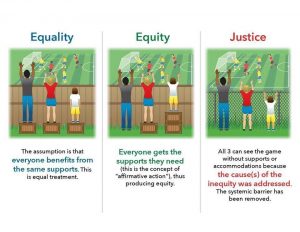Johann Redl
What are the UN’s assumptions about gender? In terms of gender equality, it is important to first think about the image that comes to your own mind when you think about gender. Does it include women of colour? And what about queer folks and people with disabilities? To make applicable assumptions about the equality and wellbeeing of all genders, we need to be radically intersectional.
How can global demands be formulated that affect all women and gender marginalized persons? The SDG’s are affecting all women and gender marginalized people. At the same time, there is a danger that certain people will disappear into subalternity. This term, which I use after Spivak, is a subject status and an alternative narrative that confronts the dominant Western narrative of colonial and nationalist elites.The voice of the subaltern is thus an expression of oppressed classes, castes, age groups, abilities, and race – who have not enough power to be heard in political discourse (cf. Spivak 1989)
For example, one of the objectives of the SDG’s is, „to ensure the full and effective participation of women and equal opportunities for leadership positions at all levels of decision-making in political, economic and public life“. But what good is this goal for those women who are unable to make use of these equal opportunities? Systemic barriers are often invisible, also in the SDGs, for example racism, which is intersecting with gender discrimination, and denies certain people to work for particular jobs. Despite these facts, racial discrimination and xenophobia are not tackled in any of the SDGs (cf. Corann et al. 2015). Therefore the goal of gender equality can not adress the problems of every person who suffers gender discrimination simply because the UN’s understanding of gender does not intersect with race (same also with ability, caste, etc.).
Also queer and trans people are made invisible through the SDGs. When they talk about gender equality, the UN talks about women and girls exclusively and do not mention other gender-marginalized positionalities such as queer, trans and non-binary. Again the SDGs work for a majority of people who suffer from gender opression while eluding the rest which leads to positions of subalternity for those who are not included. Another aspect of this is, that also the actions of men are not adressed with the SDGs, event though they are the group which is largely responsible for gender opression and therefore needs to act the most.
In addition equality, equity and justice by far do not mean the same thing. While equality means, that all people are directly involved with the same conditions, with equity everyone would get the support they need. Therefore it is impossible to adress many problematic aspects with the concept of equality. It should not be our goal to homogenize under this premise of equality and to assimilate to a capitalist, heteropatriarchal and colonial society. Instead, we need justice, namely a liberation from our system boundaries, which ultimately means a liberation for all genders. The SDGs need to adress systemic barriers and include them in their goals, otherwise this project won’t be helpful for the whole population but only for a privileged few.

Sources:
# Corann, Okorodudu et al. (2015): Integrating the Elimination of Inequalities due to Racism into the Framework of the UN Post- 2015
# Spivak, Gayatri Chakravorty (1989): Woman in Difference: Mahasweta Devi’s “Douloti the Bountiful”, in: Cultural Critique, No. 14, The Construction of Gender and Modes of Social Division II (Winter, 1989-1990), pp. 105-128
Media Attributions
- equality,equity,justice